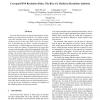130 search results - page 6 / 26 » How to Encrypt with a Malicious Random Number Generator |
IJNSEC
2011
13 years 2 months ago
2011
In this paper, cyclic elliptic curves of the form y2 + xy = x3 + ax2 + b, a, b ∈ GF(2m ) with order M is considered in the design of a Symmetric Key Image Encryption Scheme with...
CRYPTO
2010
Springer
13 years 7 months ago
2010
Springer
Coin-tossing protocols are protocols that generate a random bit with uniform distribution. These protocols are used as a building block in many cryptographic protocols. Cleve [STOC...
NDSS
2008
IEEE
14 years 1 months ago
2008
IEEE
We study and document an important development in how attackers are using Internet resources: the creation of malicious DNS resolution paths. In this growing form of attack, victi...
IJACT
2008
13 years 7 months ago
2008
: Certificateless cryptography is a promising technology for solving the key escrow problem in identity-based cryptography. However, the lack of a unified set of definitions and se...
JCSS
2008
13 years 7 months ago
2008
With the growing number of Web applications and their variety, the need to prevent unauthorised access to data and to ensure data integrity in distributed systems has led to an in...

